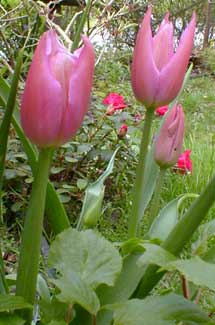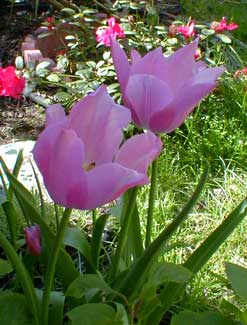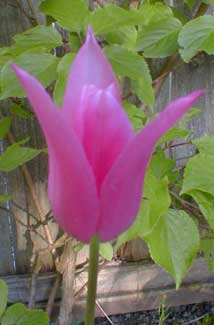
'China Pink'
Lily-flowering Tulip
"A tulip garden is
endless imagery
of the holy splendor
of the majestic Spirit."
-Jalaludin Rumi
(1207-1273)
(1207-1273)
The word Tulipan was an intentional wordplay on Tuliben (Turban) because of a presumed resemblance between the round goblet flowers & a gentleman's turban. This was more apt to be the impression of tulip appearance to westerners than to Islamic peoples, who viewed the tulip not as a headdress, but as a type of Divine Fire.
The Persian word for Tulip is Lalah. Among Sufis the tulip symbolized the Peri-face of God, a Peri being a delightful fairy or female djinn. The very Moon was said to possess this Peri-face. Allah as Peri-faced means that the One is akin to a loving bride to humanity. Lalah is thus a name of the Soul which is of God & which is that part of ourselves which desires God as the Beloved.
 At the martyrdom of the Prophet's son Husayn, where his blood flowed in the desert there arose tulips. It is believed that the reason tulips are so frequently seen in shades of scarlets, pinks, & burgundies, is because they were at one time mired in blood. Their continued redness is the brand of their grief. Husayn's blood persists as a field of tulips which are grown in his blessed memory & honor in the desert around Mecca.
At the martyrdom of the Prophet's son Husayn, where his blood flowed in the desert there arose tulips. It is believed that the reason tulips are so frequently seen in shades of scarlets, pinks, & burgundies, is because they were at one time mired in blood. Their continued redness is the brand of their grief. Husayn's blood persists as a field of tulips which are grown in his blessed memory & honor in the desert around Mecca.Because the Tulip represents a kind of ecstatic love between humanity & the divine realm, such as is at the same time the fiery essence of Life, the ideal Tulip in Turkish art had pointed reflexed petals, looking like flames. Today we call these the Lily-flowering tulips, the most sacred of a sacred genus.
 Early October 2003, we planted four 'China Pink' bulbs together with other bulbs by a gatepost near a female kiwi, with a layer of many 'Whitewell Purple' crocuses planted in a shallower level above those. The crocuses come & go well before it is time for the tulips to bloom.
Early October 2003, we planted four 'China Pink' bulbs together with other bulbs by a gatepost near a female kiwi, with a layer of many 'Whitewell Purple' crocuses planted in a shallower level above those. The crocuses come & go well before it is time for the tulips to bloom.As 'China Pink' is a recipient of the Award of Garden Merit, it was assured to be beautiful, easy to grow, & of lasting garden value. It was introduced in 1944 by De Mol & A. H. Nieuwenhuis of Holland. The Nieuwenhuis brothers were notable pioneers in developing the relatively recent division of tulips called Lily-flowering.
'China Pink' is a small-flowered lily-tulip, pink with white base, & a lighter pink rim, reaching only about fourteen inches of height. These are generally said to bloom, like the majority of lily-tulips, in May, but in our garden they are flowering by the first week in April.
Lily-flowering tulips are a small division that were previously included amidst Cottage Tulips. They are still sometimes lumped together as "Mayflowering Tulips" including also Darwins. The primary parents of the whole division are Tulipa acuminata, T. fulgens & T. retroflexa.
Lily-tulips tend to have slim stems that look delicate, but most are pretty good at standing sturdy & upright, with the flowers always having pointed petals increasing the impression of an upward thrust.
As a generality Lily-flowering tulips perennialize in place, returning stronger than ever for many years. In spring before the first tulips are rising up, they should all recieve generous amounts of bone meal, fish meal, blood meal, or kelp, but do not require nitrogen fertilizers. A winter top-coating of steer manure or leafmold can be beneficial.